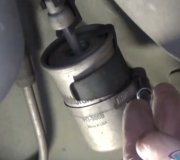This is a gauge problem. Chrysler gauges worked the same way. They have a bimetallic strip that holds the pointer. There is a heating wire wrapped around that strip. When the tank is full, the sending unit is at its lowest resistance. That means more current flows through the heating wire, then through the sending unit. The bimetallic strip gets hotter, so it bends more, and moves the pointer more. To verify you have this type of gauge, you will see the pointers go to the lowest setting very slowly, over about five seconds or more, when you turn the ignition switch off. It takes that long for the strips to cool down.
I never worked on a Ford gauge for this, but I did adjust the fuel gauge on my 1972 Dodge Challenger. You will have to look to see if yours is the same. On mine, there are two 1/4"-diameter holes in the back of the gauge. Just behind each one is a lever with a few teeth on the end that you can see. You use a flat-blade screwdriver to pry on those teeth to move the levers.
One of those levers moves the fixed pivot point the pointer is attached to. That sets the pointer's position. The second lever is attached to another part of the pointer and sets the tension placed on the bimetallic strip. If it has a lot of tension, it will resist bending when it gets hot, so the range of travel between "low" and "high" is reduced. If you relax the tension, the strip will be free to bend as much as it wants to, so the range will be increased.
The problem is trying to adjust the gauge when it is unplugged from the instrument cluster. Most of these cars used a voltage regulator that simply pulsed on and off, similar to a turn signal flasher, so the heating wire saw twelve volts, then zero volts, then twelve volts, ... But the average over time was five volts. I can tell you from experience that trying to run a gauge on a five volt power supply on the workbench will not work. The heating and cooling take time for the temperature changes to take place, and that is a factor in the gauge's operation. What I did was to use a pair of clip leads, (small jumper wires), to connect the gauge and allow it to sit on the passenger seat. That way I could adjust it while on a test-drive. Simply running it without the engine running also will not work because it will be running on a pulsing 12.6 volts, which is a fully-charged battery. You want the gauge to be accurate while driving, and then the charging system will have system voltage at 13.75 to 14.75 volts.
The first step is to get the range right, and this is going to take some time. Start with the gas tank near "empty", see where the pointer is, then fill the tank and check the pointer again. Adjust the range, or "spread" adjustment to make the pointer read higher or lower as necessary. It is okay if you get it to read 1/8 tank too low when empty, and 1/8 too low when full. The spread will be okay. This one can take multiple tanks of gas to get it right.
The last step, once the spread is okay, is to set the position with the second adjustment. Depending on the angle this adjustment puts pressure on the pointer, the two adjustments might interact slightly. You will go insane if you try to get too perfect. Stop, and be satisfied when you get the gauge to the point that you know how much gas you have.
Saturday, January 27th, 2018 AT 5:01 PM


